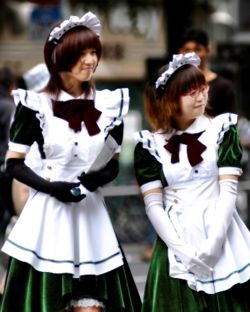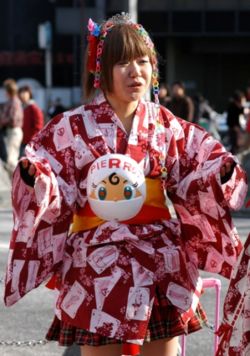Japanese popular culture: Difference between revisions
imported>John Stephenson (I'd forgotten that some of this came from WP: checking the box) |
imported>John Stephenson (Complete rewrite to remove WP sections and bring examples of culture to the forefront, in several sections; 'cute' image) |
||
| Line 1: | Line 1: | ||
{{subpages}} | {{subpages}} | ||
[[Image:United_in_different_colors.jpg|thumb|left| | [[Image:United_in_different_colors.jpg|thumb|left|400px|'[[Cosplay|Cosplayers]]' (from コスプレ ''kosupure'' 'costume roleplay') - teenagers who dress as characters from [[film]], [[television]] or ''[[animé]]'' cartoons - pose for the cameras in [[Harajuku]], [[Tokyo]]. These girls are dressed as members of the Japanese band 'Dir en grey'.<BR><small>Photo © by Sonny Santos, used by [[Image_talk:Menu.jpg/Permission|permission]].</small>]] | ||
''' | '''[[Japan]]ese [[popular culture]]''' is a highly distinct collection of [[fashion]]s, [[art]], [[music]] and other forms of expression, appearing in both mainstream [[society]] and underground [[subculture]]s. While some examples of these are widely known in the [[Western society|West]], such as [[film|cinema]]'s [[Godzilla]] monster, many today are either unique to Japan or mainly influence contemporary [[Asia]]n popular [[culture]]. | ||
Popular culture in Japan is very much the mainstream; while ancient sites are easy to find, the Japanese are rarely seen practising traditional arts such as ''ikebana'' (活花, '[[flower arranging]]'). [[Cartoon]]s, [[comic]]s and above all, anything ''kawaii'' (可愛い, 'cute') are strong influences on high-tech products and [[clothing|clothes]] available in the high street, as well as teenage and children's fashions. While young Japanese often follow overseas trends, they have also developed their own trendy [[subculture]]s that to outsiders may border on the bizarre - young people dressed in [[maid]] outfits or in [[cute]] [[Victorian]]-style '[[Lolita]]' costumes are more common a sight in Tokyo than [[tradition]]ally-dressed ''[[maiko]]'' (妓) girls in historic [[Kyoto]]. These trends come and go, reported by the huge [[media]] industry, and also find a home in the more seedy areas of Japanese society. | |||
{{TOC-right}} | {{TOC-right}} | ||
== | ==Cuteness== | ||
Much of mainstream Japanese society conforms to the idea that goods and lifestyle choices should be ''kawaii'' (可愛い, 'cute'). Baby-faced cartoons such as [[Pokémon]] (ポケットモンスター, ''Poketto Monsutaa'' 'Pocket Monster') and small gadgets, often [[pink]], are perhaps the best examples of this phenomenon, which is thought to be rooted in the rise of a Japanese [[consumer society]] in the 1970s, and also through the encouragement of dependent social relationships and the need to escape a highly stratified society.<ref>Garger (2007).</ref> Many adults adore cuteness as much as children and teenagers: for example, bank cards are available with cute cartoon characters printed on them, and though the culture of ''kawaii'' is most firmly established among young girls, grown men are prepared to be seen with cute items too. The prevalence of ''kawaii'' has led to criticism both within and outside Japan, depicting its society as one of increasing [[infantilization|infantilisation]]; such goods tend to be popular with non-Japanese children but have yet to make inroads among foreign adults.<ref>e.g. Kerr (2002:312).</ref> To a greater or lesser extent, each of the themes discussed below involves an appreciation of cuteness in some way. | |||
[[Image:Japanese-cute-bank-cards.jpg|left|thumb|200px|{{#ifexist:Template:Japanese-cute-bank-cards.jpg/credit|{{Japanese-cute-bank-cards.jpg/credit}}<br/>|}}Bank cards with cute characters on them are widely available in Japan.]] | |||
==Media== | |||
==='Idols'=== | |||
===Manga=== | |||
''[[manga]]'' (漫画 '[[comic]]') | |||
====Doraemon==== | |||
===Magazines=== | |||
===Film=== | |||
===Television=== | |||
===Video games=== | |||
====Pokémon==== | |||
==Going out== | |||
[[Image:AKIBA_Scenario.jpg|thumb|right|250px|Promoting a ''maid-kissa'' (メイド喫茶 ''meido-kissa'', 'maid coffee shop') in [[Akihabara]], [[Tokyo]] will involve looking the part; young women in maidlike waitresses' outfits are a common sight in this [[electronics]] quarter of the city.<BR><small>Photo © by Sonny Santos, used by [[Image_talk:AKIBA_Scenario.jpg/Permission|permission]].</small>]] | [[Image:AKIBA_Scenario.jpg|thumb|right|250px|Promoting a ''maid-kissa'' (メイド喫茶 ''meido-kissa'', 'maid coffee shop') in [[Akihabara]], [[Tokyo]] will involve looking the part; young women in maidlike waitresses' outfits are a common sight in this [[electronics]] quarter of the city.<BR><small>Photo © by Sonny Santos, used by [[Image_talk:AKIBA_Scenario.jpg/Permission|permission]].</small>]] | ||
==='Water trade'=== | |||
====Hostess bars==== | |||
===Karaoke=== | |||
''[[karaoke]]'' (カラオケ, 'empty [[orchestra]]') | |||
===Pachinko=== | |||
===Theme parks=== | |||
==Fashion and subcultures== | |||
[[Image:Harajuku_Up_&_Close.jpg|thumb|left|250px|Traditional and modern meet on the streets of [[Harajuku]], [[Tokyo]].<BR><small>Photo © by Sonny Santos, used by [[Image_talk:Menu.jpg/Permission|permission]].</small>]] | |||
===Office workers=== | |||
===Cosplayers=== | |||
===''Otaku''=== | |||
===Crazes=== | |||
==Technology== | |||
===Internet=== | |||
(blogosphere; Mixi) | |||
===Virtual characters=== | |||
===Robots=== | |||
===''Purikura''=== | |||
==Relationships== | |||
===Love hotels=== | |||
===Gay Japan=== | |||
=== | ==Sex industry== | ||
===Soaplands=== | |||
===''Enjo kousai''=== | |||
==Footnotes== | ==Footnotes== | ||
| Line 20: | Line 59: | ||
==See also== | ==See also== | ||
*[[Culture of Japan]] | *[[Culture of Japan]] | ||
*[[Japan]] | |||
*[[Popular culture]] | *[[Popular culture]] | ||
*[[Culture]] | |||
Revision as of 22:19, 18 February 2008

Photo © by Sonny Santos, used by permission.
Japanese popular culture is a highly distinct collection of fashions, art, music and other forms of expression, appearing in both mainstream society and underground subcultures. While some examples of these are widely known in the West, such as cinema's Godzilla monster, many today are either unique to Japan or mainly influence contemporary Asian popular culture.
Popular culture in Japan is very much the mainstream; while ancient sites are easy to find, the Japanese are rarely seen practising traditional arts such as ikebana (活花, 'flower arranging'). Cartoons, comics and above all, anything kawaii (可愛い, 'cute') are strong influences on high-tech products and clothes available in the high street, as well as teenage and children's fashions. While young Japanese often follow overseas trends, they have also developed their own trendy subcultures that to outsiders may border on the bizarre - young people dressed in maid outfits or in cute Victorian-style 'Lolita' costumes are more common a sight in Tokyo than traditionally-dressed maiko (妓) girls in historic Kyoto. These trends come and go, reported by the huge media industry, and also find a home in the more seedy areas of Japanese society. Template:TOC-right
Cuteness
Much of mainstream Japanese society conforms to the idea that goods and lifestyle choices should be kawaii (可愛い, 'cute'). Baby-faced cartoons such as Pokémon (ポケットモンスター, Poketto Monsutaa 'Pocket Monster') and small gadgets, often pink, are perhaps the best examples of this phenomenon, which is thought to be rooted in the rise of a Japanese consumer society in the 1970s, and also through the encouragement of dependent social relationships and the need to escape a highly stratified society.[1] Many adults adore cuteness as much as children and teenagers: for example, bank cards are available with cute cartoon characters printed on them, and though the culture of kawaii is most firmly established among young girls, grown men are prepared to be seen with cute items too. The prevalence of kawaii has led to criticism both within and outside Japan, depicting its society as one of increasing infantilisation; such goods tend to be popular with non-Japanese children but have yet to make inroads among foreign adults.[2] To a greater or lesser extent, each of the themes discussed below involves an appreciation of cuteness in some way.
Media
'Idols'
Manga
Doraemon
Magazines
Film
Television
Video games
Pokémon
Going out

Photo © by Sonny Santos, used by permission.
'Water trade'
Hostess bars
Karaoke
karaoke (カラオケ, 'empty orchestra')
Pachinko
Theme parks
Fashion and subcultures

Photo © by Sonny Santos, used by permission.
Office workers
Cosplayers
Otaku
Crazes
Technology
Internet
(blogosphere; Mixi)
